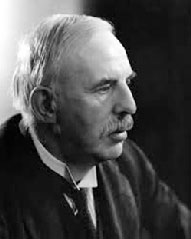
Proton
Image: Ernest Rutherford (30 August 1871 – 19 October 1937), discoverer of the proton and the father of nuclear physics.
The proton is a massive, positively charged particle made up of two up quarks and one down quark. It therefore has half-integral spin and is a fermion. Atomic nuclei are made up of protons and (for every element except hydrogen) neutrons, bound together by the strong nuclear force. The number of protons roughly equals the number of electrons in a neutral atom. Proton number is also called atomic number, as it dictates all of the chemical properties of the atom.
At 1.673×10-27 kg, protons are the lightest of the baryons and, since baryon number is conserved, they are stable. For many years it was thought that protons mist eventually decay, in accordance with various grand unification models developed in the early ‘70s. However, observation has put a lower bound on the proton lifetime vastly greater than the age of the universe, at more than 6.6×1033 years via antimuon decay, and at more than 8.2×1033 years via positron decay.
The concept of protons or proton-like objects ran through much of 19th century chemistry. In 1815 William Prout conjectured that all elements were made up of hydrogen, and positive ions (cations) were extensively studied in electrochemistry. However, since no unique charge-to-mass ratio could be measured (in contrast to the situation with the electron) the existence of the proton was not readily inferred. The situation changed in 1917 when Rutherford proved that the hydrogen nucleus was to be found in other elements; it was he who coined the word ‘proton’.
Links
Multimedia
Best of Science: Electrons, protons, and neutrons. The standard model of particle physics >
Cloud Biography: Ernest Rutherford biography >

